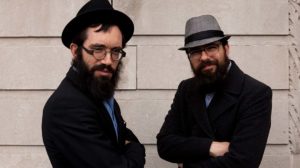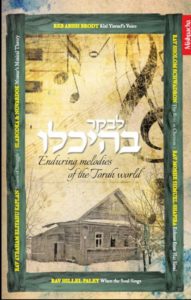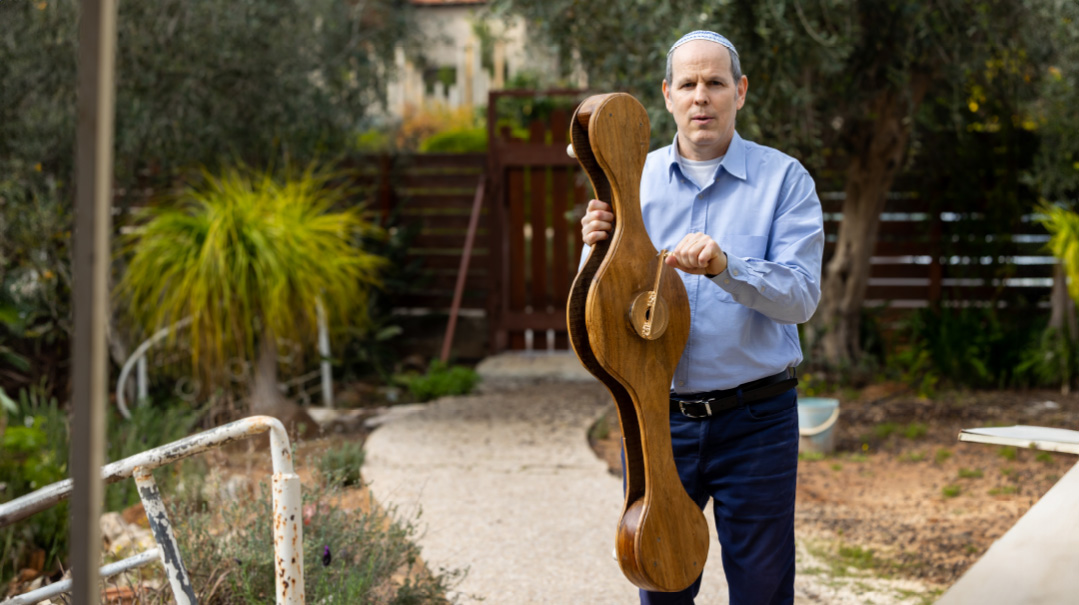Rebound
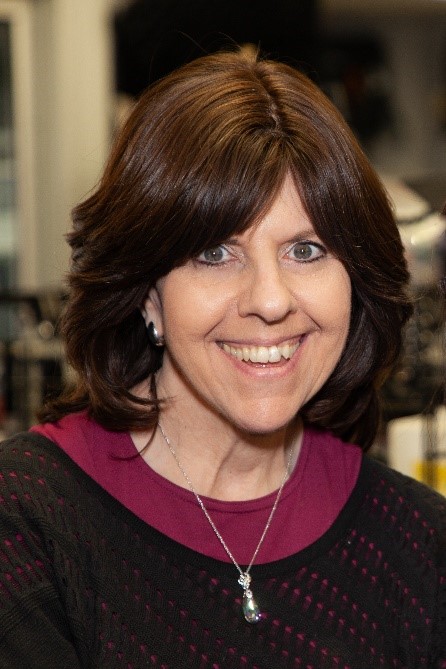
Jackie Spivack showed his strength from the time he was born with a challenging handicap. Following two successful careers, he reinvented himself as a master binder
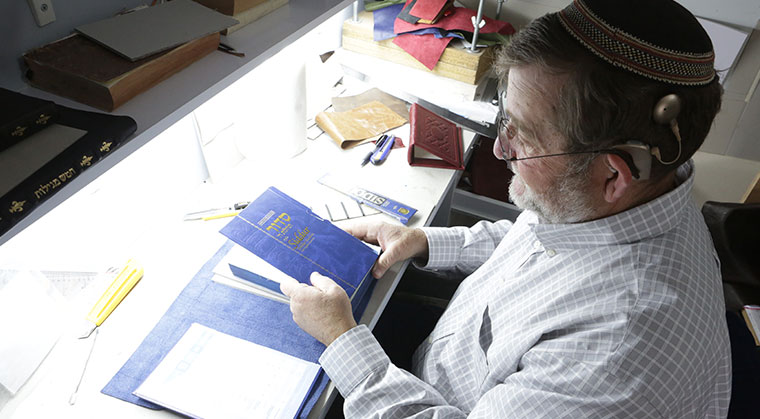
The well-known quote “You can either allow the obstacles in your life to be the excuse for your failure or you can make them the reason behind your success” describes Jackie Spivack
I
t’s an ancient art, something you’d expect to find in the shop of an elderly craftsman tucked away in a corner of Meah Shearim, not in the modern Efrat bedroom-studio of a retired accountant from Baltimore. In fact, the first time Jackie Spivack was told about Renaissance-era handcrafted bookbinding following his retirement, it was the last thing in the world he’d consider — until curiosity got the better of him. “It was love at first sight,” he says about the hobby and craft he’s now mastered.
Mastering new frontiers, though, is nothing new for Spivack, who at an early age learned to overcome a hurdle most of us could never fathom. Ever since birth, when Jackie was born hearing-impaired, he has never let his lifelong challenges become an excuse for not moving forward. Becoming a Renaissance leather bookbinder is Jackie’s most recent successful attempt to reinvent himself — this time, post-retirement, after successful careers as an accountant and as the owner of an aluminum company. And he’s finally making good on the childhood prediction made by a concerned pediatrician who said he would grow up to create with his hands.
The well-known quote, “You can either allow the obstacles in your life to be the excuse for your failure or you can make them the reason behind your success,” describes Jackie Spivack, who never let his handicap stop him from achieving what might have seemed to be out of his grasp — although, he says, “A lot of people like me, with the type of loss I have, didn’t make it through.”
Undaunted
Jackie’s parents didn’t immediately realize that their premature baby was born hearing-impaired. Back in 1949, you couldn’t know that without the testing available today. They only realized something was amiss when he wasn’t speaking on the same schedule as his older and younger sister, who had verbally surpassed him. At the age of three, they sent him to the world-renowned speech and hearing clinic at Johns Hopkins Medical Center — which would be the beginning of his annual visits.
Growing up in the ‘50s, Jackie’s teacher made him talk without using his hands, in order for him to become proficient in speech and lipreading.
“One day when I was a little boy,” recalls Jackie, “I asked my father, ‘Why do you keep buying me expensive stuff, like a chemistry set or an airplane model? Most of my friends don’t have anything like that.’ It was because the doctor told my parents that they had to buy things that would help me become creative with my hands, since I wouldn’t be able to hear anyone talking.”
The Spivacks sent their three daughters to the local Bais Yaakov, and started Jackie off in Talmudical Academy for kindergarten. “But they couldn’t handle me there, so I went to a class for hearing-impaired children in P.S. 83, in downtown Baltimore, for first grade,” Jackie says. “My teacher happened to be shomer Shabbos, and she was so good, my father hired her to work with me for the next 14 years. It was only after I finished high school that P’TACH created a program for frum special-needs children.”
Switching schools a couple of times, Jackie ended up in a school for special children with all kinds of handicaps. He went for lipreading therapy for one hour, and speech therapy for another hour, every day until ninth grade.
Still, Jackie, remembers, “I never felt comfortable going to shul as a kid. I didn’t know Hebrew until I was ten. As my bar mitzvah was approaching, some people in shul didn’t think I was capable of reading the maftir — ‘Maybe he could just say the brachos,’ they told my parents.
“My mother decided they would go speak to the president of the shul,” Jackie continues. “My mother said to him, ‘Moshe Rabbeinu didn’t speak well either, and he got through everything.’ On the day of my bar mitzvah, I said the maftir. Afterward, about a hundred people came over to me at the bimah and shook my hand, as if to apologize.”
When Jackie was about 16 years old, Rabbi Chaim Dovid Lapidus began teaching him Judaic studies at yeshivas Ner Israel, and continued for the next two years, although he says he never had a real learning background in the basics like Chumash and halachah. In fact, as recently as eight years ago, he began learning Gemara every morning for three hours with a chavrusa.
He was mainstreamed in high school and, in 11th grade, because he had excellent marks, the Maryland state government came to his school to offer him a full, four-year university scholarship. Jackie took them up on it and became an accountant.
Heeding the Call
Jackie says that after completing university, his parents wanted him to “get lost around the world.” He decided to visit his sister who was living in Johannesburg, married to Rabbi Zadok Suchard. The first Shabbos he was there, as he was walking to his host’s house for Shabbos lunch, he met his future wife, Leah Edelman, a native of Johannesburg.
“People assume that the hearing impaired should marry someone else with the same handicap, and that’s how it usually goes. But Leah, who hears perfectly, took me as I am. Her father was a doctor and he had no objection.”
Jackie was 26 when they got married; Leah was 20. After the wedding in South Africa, the couple moved to Baltimore, where they lived with their four sons until making aliyah in 1986 — and Jackie left his job as a negotiation accountant for the federal government at Health Care Financing Administration (HCFA).
“We tried living in Israel for two months a year before making aliyah,” Jackie says. “I took a chance — I wasn’t sure what it would be like, having a hearing impairment. It’s not so easy to move, to pack up and go, especially if you have everything in the States, including government benefits and promotions. But the year before, there were government cutbacks and that was a consideration in making our decision. Before moving, I went to see a top speech therapist in Jerusalem to seek her advice about making aliyah. She said, ‘You can do it!’ So we did.”
Jackie’s Hebrew was basically nonexistent, so he knew his career would be over once he got to Israel. “After we made aliyah, I had an interview at Bituach Leumi, which is like their Social Security. The man who interviewed me said that I should be sitting in his chair, because he was so surprised about how much I knew about medical reimbursement. Five years later, they even offered me a job, but I was already established in my business.”
Not easy to retire
They had bought a home in Jerusalem’s Har Nof neighborhood, and needed to install security window bars. That was the catalyst for his next career. “When the business owner came to install them, my wife told him, ‘We don’t know how long we’re going to be here because my husband doesn’t have a job.’ He offered to train me in his factory, and just a few weeks later, he decided he didn’t want the business anymore. He suggested I take it over and that’s how I got started.”
Jackie opened his aluminum business in 1987. Most of his customers were Anglo-Saxon. He spoke broken Hebrew to his customers and to his suppliers — who were very understanding of him and permitted him to go into the back room to choose his supplies. “Leah helped me communicate better,” notes Jackie. “She made my aluminum business appointments at night, after her work as a radiologist technician at kupat cholim.” He hired a deaf employee and expanded his aluminum and security bar business to include carpentry and renovations. He built up Spivack Aluminum and Spivack Carpentry, working together with his son, who took over the business after Jackie retired about seven years ago.
“In Israel, it’s not so easy to retire,” Jackie, who eventually moved with his family to the town of Efrat, explains. “A couple years ago, a friend of mine approached me and asked if I would be interested in doing bookbinding to keep me busy. I told him, ‘Leave me alone; I’m not interested in doing bookbinding.’ ”
Heeding the Call
But last year, Jackie’s curiosity — and his inactivity after his morning Gemara seder — finally got to him. This friend didn’t give up, and took him to an octogenarian bookbinder who produces around 400 hand-bound books annually, finally convincing him to take a look.
“It was love at first sight,” says Jackie. “After six months of training, learning the basics one-on-one with this Master Renaissance leather bookbinder and other bookbinders after that, I decided to go out on my own. That’s how I started my own company, ‘Smell and Feel the Leather.’ ”
Jackie is one of the few Jewish Renaissance leather bookbinders, not only in Eretz Yisrael, but in the world. Hand-tooling genuine leather is a specialty that is a dwindling art —although this ancient craft is still practiced primarily in Europe. Jackie’s customers include those whose family heirlooms need refurbishing or those who prefer a richer cover on a new book. Others purchase hand-bound books for gifts.
Jackie demonstrates just some of the laborious, minimum 69-step leather bookbinding process, and encourages me to feel and take a whiff of his luxurious treated hide samples — snakeskin, cowskin, goatskin, and sheepskin — which are about to turn into unique handcrafted, personalized keepsakes or gifts. The rich leather scent of the siddur he is customizing for a client reminds me of the aroma of an expensive shoe store. He prefers to work with cowhide, because of its superior texture. It’s also the most expensive and the biggest of all skins — as big as the cow, about four by eight feet, or larger. Books made from the fancier leathers, like the purple-dyed snakeskin, are among the most expensive, since working with it is very labor-intensive.
“The style I use is based on a classic Renaissance-era binding process used by craftsmen in the late 16th, early 17th century,” Jackie explains. “For some of my books, I combine Renaissance and Modern. I’m hoping to work with ostrich skin, which has holes in it left from the feathers. It’s a very strong skin and is just beautiful when you polish it.”
Cover to Cover
In contrast to high-speed commercial book production in which all 69 steps are done at one time, taking just minutes to complete, Jackie’s one-of-a-kind boutique creations can take hours to make. The drying of the glue alone takes up to 24 hours. As the glue on one volume dries, he starts binding other books, going back and forth between them.
“First, I completely rip off the cover, whether it’s a new or used book,” Jackie says as he demonstrates on a small volume that’s falling apart. If the book is produced in Israel, the spine is usually curved, patterned after 16th- and 17th-century bookbinding; the book spines of American-made books are straight-edged. He adds a band on the book spine to reinforce and protect the book.
“Fancy ribbons come before the cloth is added to hold the pages together, between the spine and the cover,” Jackie explains. “Some books only have one ribbon; I sometimes use three or four. If the book is small, I use a thin ribbon; if it is big, I use a wider satiny ribbon.”
Jackie gives me two different swatches of cloth to rip, in order to compare their durability. One just about crumbles apart. It feels like the material in an old, sentimental siddur I still use, which looks like it’s bound in leather, but I now know isn’t. The untearable one, called Irish linen, is obviously the more durable one. That is the one Jackie uses to glue to the spine of the book, to reinforce it.
“The Irish linen and the hand tools are from overseas — you can’t buy them in Israel,” notes Jackie, who built his own press machine — his main bookbinding tool — to save the $5,000 to $6,000 expense of an imported machine. “I go to Tel Aviv to buy the imported tanned leather skins of all different kinds of animals; the snakeskin, I order online from Asia. I buy the special glue and paper I use in Jerusalem. And the books I bind? I buy them around the corner at the bookstore.”
The scent of a korban
Before Jackie got his cochlear implant five months ago, it was harder for him to communicate with customers, because his hearing aid wasn’t very good. Now he goes to Shaare Zedek Medical Center for therapy to learn how to recognize the new sounds of words.
“I never heard the sound of rain hitting the car, the sound a zipper makes, or the sound of brushing teeth, until I got my implant,” says Jackie. “There are so many new sounds — some I could hear, but very faintly. Now I’m speaking better too, because I can hear myself talk.”
“Jackie is the motivated one. He always wants to better himself,” says his wife Leah. “He’s never looked at himself as handicapped and I’ve never looked at him that way either, because he is so bright, witty, loving, and giving.”
And it’s never stopped him, not from becoming a noted CPA, from starting life over again in Israel with his own business, or reinventing himself as one of the world’s rare Master Renaissance bookbinders.
Jackie moves to the clamp machine to secure the book he is about to work on. Hooking the leather in and designing the book are done on the book press. Since the entire process is based on ancient design, nothing here is electric — the pressure comes from an old-fashioned wheel similar to the machine used to press grape juice by hand.
“Before I glue the book, I design the book,” notes Jackie. “I can do things like emboss it, stamp it, add a gold rim around the periphery of the cover, and put a fancy label on the spine with the name of the book.”
Next, Jackie chooses from an assortment of 35 decorative papers for the first and last page inserts. After meticulously trimming them, he will glue them into the front and back of the cover, making it tension-free for easy opening. The newly papered insides of his creations are flush, he points out; not bumpy like those in some machine-made volumes.
Jackie shows me a creation he’s most proud of — a custom-made siddur he made for his wife, complete with colorful place-holding ribbons and a removable, plastic-covered bookmark listing the names of all their children and grandchildren.
How do people know about his craft? “Whenever I finish a book, I take it to the Shacharis minyan and leave it on my table while I daven,” Jackie admits. “People look at it… and I get my customers, mostly by word of mouth.”
After learning what goes into each and every volume, I gained a whole new appreciation for the luxuriously bound seforim before me: a siddur, machzor, Haggadah, Perek Shirah, Tehillim, Megillah, and Tanya. One of my favorites, in the “coffee table” book pile, is a colorfully illustrated Beis Hamikdash book, which I thumb through.
Taking note, Jackie mentions, “If you daven from a siddur that has the smell and feel of real leather, it can remind you of the animal sacrifices brought thousands of years ago in the Beis Hamikdash, before our tefillah system was even instituted.”
(Originally featured in Mishpacha, Issue 692)
Oops! We could not locate your form.

